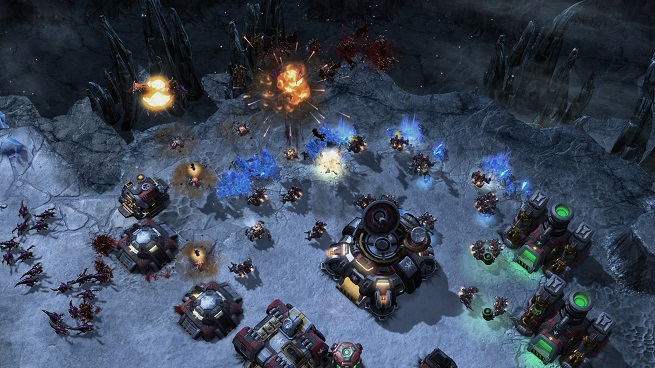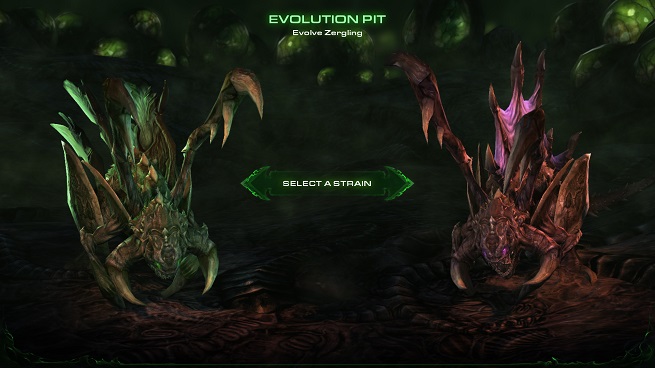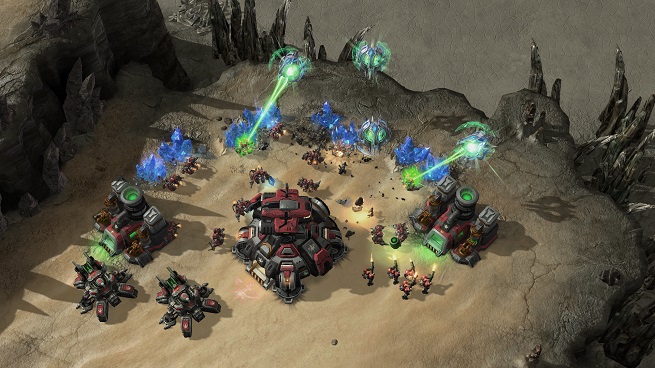
This review may contain story spoilers. For tips on playing Heart of the Swarm, please check out our guide.
StarCraft is like reconnecting with an old buddy. You might liken the series, as critic Tom Chick does, to a muscle that needs exercise lest it atrophy, but that sounds like work. StarCraft isn’t a muscle; it’s an ongoing conversation.
And even if you fall out of touch with a good friend, you’re quickly reminiscing on past times and catching up on what’s new when you reunite. And such it is with developer Blizzard Entertainment’s Heart of the Swarm expansion for the PC-exclusive, real-time strategy game StarCraft II.
Returning to this finely tuned RTS after even a short hiatus inevitably requires you to reacquaint yourself with its mechanics and systems. What’s the build order to get my “MMM ball” (a group of Marines, Marauders, and Medivacs) up and running quickly again? Is the Banshee rush still a viable opening? After having that talk, you’re ready to dive into the new stuff.
Heart of the Swarm brings seven additional multiplayer units. Aside from to the single-player Zerg campaign, these soldiers are why seriously competitive StarCraft players are salivating over picking up this expansion.

What You’ll Like
Increased tactical flexibility
The new multiplayer units — two each for the Terran and Zerg factions and three for the Protoss — easily fit into specific roles on the battlefield.
Our spacefaring cowboys now have the Hellbat and Widow Mine. The former is a heavily armored vehicle that can “transform” from a walker into a buggy. It can form a frontline barrier between your opponent and your squishier Marines and Marauders, and its flame area-of-effect attack can effectively counter swarming enemies. The Widow Mine burrows into the ground, hiding from approaching enemies, and launches seeking rockets at your foes. It can provide an effective defensive line at chokepoints and for resource gatherers.
The Alien-like Zerg can now field the Viper and Swarm Host. The former mutates from the Mutalisk, a flying fast-attack harasser, and comes with two special abilities. You can grab a single enemy unit and pull it into your army for a quick death or drop a cloud that prevents ranged fire. Used together, the Viper can help your army break through your opponent by taking out high-profile enemies quickly and suppressing the counterattack. The Swarm Host is a slow-moving creature that spawns Locusts off its back when burrowed. This unit serves as a ground-based siege unit.
The Protoss get three new troops: the Mothership Core, Oracle, and Tempest, all flying units. The three fill support roles for your main army: The Mothership Core can boost the defensive capabilities at your Nexus headquarters while the Oracle acts as a harassment unit to slow down your opponents’ economy. The Tempest is a long-range siege weapon that gives any assault additional firepower from the relative safety of your back lines.
The campaign is StarCraft’s ‘relax’ mode
While not nearly as diverse as the previous Terran campaign in Wings of Liberty, Heart of the Swarm’s Zerg focus still offers a series of varied mission scenarios. As Sarah Kerrigan, known as the Queen of Blades, you’ll fight on an ice planet that freezes units every few minutes. You’ll scout and eliminate certain marked targets before a countdown reaches zero. Sometimes Heart of the Swarm turns into an action role-playing game with Kerrigan as the hero in linear levels complete with, for lack of a better term, “boss” characters.

That last one provides the template for one of the more appealing side-diversions from StarCraft proper. The series has always tipped its hat at its influences (like this scene for Aliens and this one for Apocalypse Now), and Heart of the Swarm continues this tradition. Upon impregnating a Protoss researcher with a Zerg larva, Kerrigan allows the doomed enemy’s allies to beam her to an escaping starship, where the creature will burst from its host’s chest, consume those aboard, grow into an unstoppable killing machine, and quickly infest the craft to cut off its getaway.
The only thing missing is a mouth inside a mouth.
But the best thing about the campaign is that it feels like I’m scouring Blizzard’s cutting-room floor of interesting-yet-unbalancing unit concepts. Since the single-player portion has hardly ever developed past static A.I. enemy placement covering the entire map (and Heart of the Swarm is no different), Blizzard doesn’t have to worry about preserving its carefully designed competitive RTS formula. Here is where I can test-drive the Aberration, a centaur-like tank creature with pulsating purple bubbles covering its back, for instance.
I can also choose between two different evolutionary paths for all my minions, which all seem like great ideas that would horribly wreck StarCraft’s carefully tuned competitive formula. With Ultralisks, for instance, I can choose between a poison sack upgrade that bestows additional damage to each swing of their four powerful bone scythes, or I could go with an ability that resurrects fallen Ultras upon each death on the battlefield.
These are the only permanent choices I have to contend with, though. When unlocking new units, you can visit the Evolution Pit, where Abathur (whose voice and speech mannerisms are clearly modeled, in this critic’s eyes, after The Fifth Elements’ Mondoshawans) adapts the swarm to the shifting needs of its queen. You can activate one of three different abilities for each of your creatures at any given time and swap them at will. This sort of flexibility is comforting because you won’t have to replay the campaign to try other options, and I honestly can’t think of any good reason to trudge through here more than once.

What You Won’t Like
StarCraft II probably didn’t need the new units
While the new multiplayer troops offer additional flexibility — and I look forward to seeing what pro players are able to do with them — they also feel somewhat uninspired and provide overlapping roles to existing soldiers from Wings of Liberty.
The Hellbat, for instance, is clearly channeling the fan-favorite Firebat from the original 1998 game. But its other half, the Hellion buggy that it can transform into, has been a part of StarCraft II from release. The cone of the flame attack is wide instead of long, and it’s armored instead of fast, but you’re going to use them mostly against weak swarming enemies, and the Hellion is already suited to that. The Widow Mine, again clearly designed after the original game’s Spider Mine ability on the Vulture hover-cycle, has a short range — any advancing enemy with a detector will make short work of them — but it shines against mass ground-based melee units with its explosive payload … one that’s very similar to the Raven’s Seeker Missile.
The Viper’s cloud ability comes from the original’s Defiler support unit, but unlike before — as StarCraft purists will notice — it’ll also affect your own units’ ranged fire, limiting its effectiveness. Swarm Hosts are slow moving and have a lengthy setup time of burrowing, releasing Locust egg sacks, and then waiting for the critters to hatch and move toward the enemy. They feel like an attempt to give Zerg a Terran Siege Tank, but the long preparations required means that they won’t be the key unit turning the tides of battle, and Brood Lords already fill this role from the skies.
The Protoss have the best-thought-out of the bunch even with the Mothership Core just being a weaker version of the existing Mothership. Blizzard has positioned the Oracle as a gatherer harassment unit designed to pick off hapless drones, SCVs, and probes and mess with the opponent’s economy. The Phoenix, though, already fills this role well. The Tempest gives Protoss a long-range flying heavy-hitter despite the Colossus being an excellent siege unit. The method is a little different but the roles are very similar.
The campaign is a little bit ‘Days of our StarCraft Lives’
Heart of the Swarm has nothing to say, and it is never more apparent than when Kerrigan needs to rescue Jim Raynor from the clutches of Emperor Mengsk. A dashing young prince sporting impressively large pauldrons says that the Battlecruiser holding our favorite rugged space marine is set to jump periodically to randomly selected coordinates in space. It’s impossible to get Raynor, he says. Kerrigan replies that the ship would need to resupply, and our royal friend with the massive shoulder pads says “exactly” with completely unearned confidence. Wasn’t he just lamenting that tracking this ship is hopeless?

Characters in Heart of the Swarm utter lines — dialogue consisting of “wisecracks” so cheesy that even Arnold Schwarzenegger would decline the script — to merely move along the plot. At times, they may come maddeningly close to making a point, but they quickly abandon larger concepts to advance the story to the next big action set piece. And even then, Heart of the Swarm never presents or organizes these ideas into a cohesive theme. All you’re left with is empty musings on “power” and the “final war.”
Blizzard presents the campaign with the same enthusiasm for a well-crafted narrative as a certain sci-fi director of a certain prequel trilogy that we all love to hate. That is to say, prepare yourself for a lot of boring conversation with over-the-shoulder camera shots sandwiched in between spectacular prerendered battles. Repeat ad nauseam. Roll credits.
The story hits you with a whimper, builds up to nothing, and quickly leaves your mind as if you’d not just spent the last 27 missions guiding Kerrigan through this ultimately fruitless journey.
Conclusion
No one expected the single-player campaign to be a milestone in video game literature, so I can excuse its meandering tone and appreciate it as a window into StarCraft’s development. That development, though, began in 2003, seven years before the initial release of Wings of Liberty. That’s not uncommon for the studio, but it also means that Blizzard has had a lot of time to expertly balance its pinnacle of RTS design.
The decision to split off the campaign into three separate releases, though, creates fan expectation that Blizzard will add new units for multiplayer with each expansion. Heart of the Swarms’ additions, while adding flexibility, are ultimately uninspired, drawing too much from the past rather than bringing something new to the table. Based on this showing, I’m worried about what Blizzard can meaningfully include with the upcoming Protoss campaign, Legacy of the Void.
Score: 80/100
StarCraft II: Heart of the Swarm released for PC on March 12. Blizzard Entertainment provided GamesBeat with a download code for the purpose of this review.
VentureBeat's mission is to be a digital town square for technical decision-makers to gain knowledge about transformative enterprise technology and transact. Learn More
